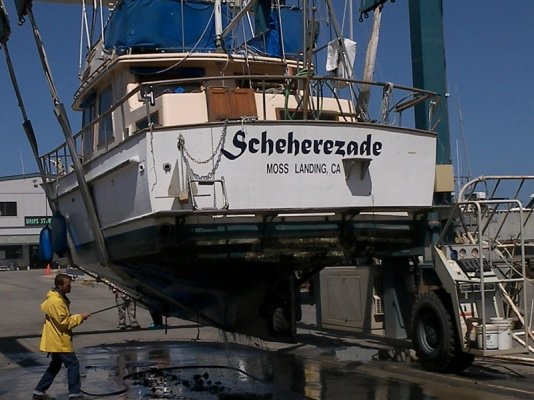RT Firefly wrote:*Beyond*what angle does the Simms pump exibit problems?
*** Thanks
It isn't' a problem, really, it just can make a mess when the oil that's above the level of the breather gets blown out.* If I recall correctly, the breather fitting is a bit higher on the pump cover than the fill level plug.* So I suppose you could draw a line between the breather and the level plug and when the line became level as you tilted the back of the engine down, that would be the angle you're asking about.* Lot of trouble to do this, though.....*
Some boats put their engines at more of an angle than others.* In our twin-engine GB, the engines sit at a not-insignificant angle.* It doesnt' look like much when you're in the engine room, but when the boat's on the hard and you look at the angle the prop shafts are at, it's a pretty good angle.* Other boats, probably singles in particular, might not have the engines at such an angle.
I assume the oil-breather wasn't an issue in vehicles since they were angling up, down, and level al the time*as they were operated and the lube oil was getting thrown around on the pump's drive mechanism.* Plus any oil that came out of the breather ended up on the ground so nobody cared.
It's a more constant issue when the engine sits all the time at a rearward slant.* Because the base engine for the FL120 (the Ford of England Dorset engine) proved to be a failure as a truck engine, most of them ended up in agricultural or industrial applications.* Most if not all these applications held the engine in a horizontal attitude all the time.
Also, it's the nature of the Simms beast to wear down*its injection plunger and bore walls as the pump runs. The plungers are lubricated in their bores by the fuel they are pumping, not by the oil in the sump which is there only*to lubricate the pump's plunger drive system.* (This is why it's important that the fuel that goes through an FL120 have a high level of lubricity--- it minimizes the plunger/bore wear although it won't eliminate it completely.)
As the plungers and bores wear, fuel can escape down the bore past the plunger and end up in the lube oil.* This dilutes it and also gradually increases the volume of lube oil.* This is why the *manual specifies a 50 hour pump oil change interval--- it ensures that, even in a pump that is nearing the end of its life in terms of plunger and bore wear, the lube oil will still do a good job of lubing the drive mechanism.
Anyway, as fuel gets into the lube oil, the level goes up, so more stuff is blown out the breather hole.
Blocking off the stock breather and providing another breather at the top of the pump *doesn't cure an inherent problem with the pump, it just eliminates a potential source of oil mess*down in the drip pan or wherever the pipe runing down*from the stock breather happens to go.* It's not a big deal, it's just a nice modification that can be made if the breather is the source of oil in the drip pan or wherever.
-- Edited by Marin on Monday 21st of June 2010 11:53:00 AM


